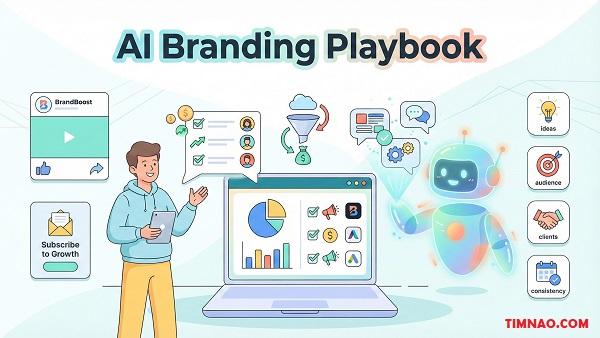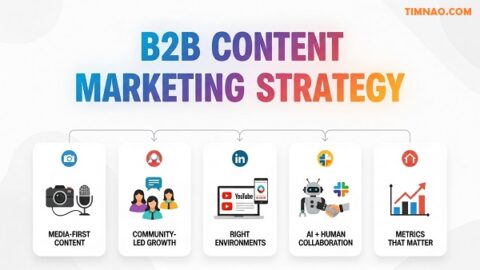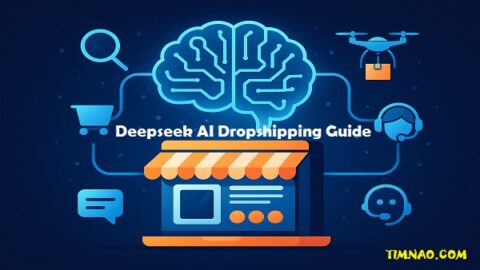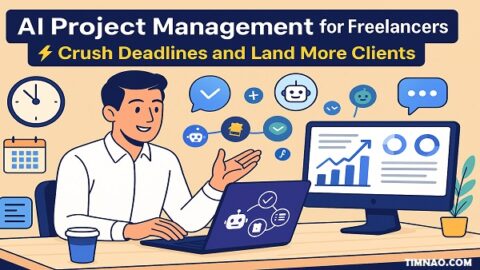AI Branding Playbook: The Essential, Profitable Roadmap for Beginners 🚀
AI Branding Playbook is your practical roadmap for turning “all this AI stuff” into a real income-boosting brand, even if you’re starting from scratch. Instead of drowning in tips, tools, and trends, you’ll follow a simple, structured checklist that shows you exactly what to do, in what order, and why it matters for your bank account—not just your follower count.
If you’ve ever stared at a blank screen thinking, “What do I even post?” or “Why is nobody buying, even though I’m showing up?”, this guide is for you. You’ll learn how to choose a focused audience, shape a money-ready offer, and use AI as your assistant for research, content, and personalization—without losing your human voice or sounding like a robot.
You don’t need to be a tech person, designer, or marketing pro. You just need a clear money goal, a few hours a week, and the willingness to test small steps consistently. The playbook will help you connect the dots between branding, AI, and actual revenue: more leads, better-fit clients, repeat customers, and higher perceived value.
As you go through the sections below, treat this like a hands-on workbook, not a theory article. Take notes, pause to implement, and let each step stack on top of the last. That’s how your brand shifts from “nice idea” to a system that quietly works for you in the background.
What This Playbook Helps You Achieve (and Why It Matters for Money)
What You’ll Actually Be Able to Do
This playbook is here to help you answer a simple but powerful question:
“How do I use AI to build a brand that actually brings in money, not just likes?”
By the time you work through the full checklist, you’ll be able to:
- Choose a clear audience and problem instead of trying to be “for everyone”.
- Turn that problem into a simple, specific offer people understand and can say yes to.
- Use AI tools as your assistant and creative partner, not as a confusing black box.
- Show up online with a consistent voice and message that feels human, not robotic.
- Build a small, realistic Brand OS – a weekly routine that keeps your brand visible and leads coming in.
You won’t just “know about branding” in theory.
You’ll have a concrete way to show up, talk about your work, and invite people to pay you.
How This Translates Into Income and Opportunities
Branding can sound fluffy, but in this playbook it’s always tied to money.
Follow the checklist and you’ll:
- Attract people who are already thinking about spending money to solve their problem.
- Make it easier to charge more because your brand and offer feel more focused and premium.
- Create more chances for people to discover you, trust you, and hire you.
- Stop wasting time on random posts or tactics that don’t connect to clear offers.
Think of your brand as your 24/7 salesperson:
- Your content warms people up before you ever talk to them.
- Your offer and messaging answer many objections in advance.
- Your AI-powered systems help you stay consistent, even on busy weeks.
You’ll still need to do the work: talk to real people, make offers, deliver value.
But instead of guessing every day, you’ll be following a practical, money-aware plan you can grow over time.
Who This Checklist Is For (and Who Should Skip It)
Who Will Get the Most Value
This checklist is built for beginners and early-stage builders, not big teams.
You’ll get a lot from it if:
- You’re a freelancer, creator, consultant, or small business owner who wants more clients or sales.
- You’re curious about AI but feel overwhelmed and want a guided, low-stress way to start using it.
- You’ve tried posting content or “building a brand,” but it hasn’t turned into consistent income yet.
- You like the idea of working with simple systems and routines, not complex funnels or dozens of tools.
You don’t need to be:
- A designer
- A tech expert
- A marketing pro
You just need to be willing to experiment, talk to real people, and give the framework a fair chance.
Who Should Probably Skip This Playbook
This is not the right guide for everyone, and that’s okay.
You might want to skip this playbook if:
- You’re looking for a get-rich-quick scheme or “push button to make money” trick.
- You expect AI to do everything for you while you sit back and watch the money roll in.
- You already run a large brand with a full marketing team and need deep enterprise strategy.
- You refuse to talk to customers or test anything in the real world.
This checklist assumes you’re ready to:
- Take small actions consistently.
- Be honest about what’s working and what isn’t.
- Use AI as a helper, not as the entire business.
If that sounds annoying or too “hands-on,” this probably won’t be your favorite playbook.
How to Know If This Is “Your” Framework
If you’re still unsure, check in with these quick questions:
- Do you want to earn more money from your skills, products, or services in the next 3–6 months?
- Are you willing to pick a specific audience instead of trying to talk to everyone?
- Would you be okay spending at least a few hours per week building and testing your brand system?
- Does using AI to save time, get ideas, and personalize your communication sound helpful?
If you’re nodding along to most of these, this playbook is a good fit.
If you feel a small mix of excitement and nervousness, that’s even better—that usually means you’re about to grow.
Quick Foundations: The Minimum You Need to Understand
Before diving into the deeper steps, we only need a few key ideas.
You don’t have to know all the theory behind branding or AI.
You just need enough foundation so the checklist feels logical, not confusing.
Foundation 1 – Your Brand Is a Money Relationship, Not Just a Logo
Most beginners start with logos, colors, and fonts.
Those things are nice, but they’re not where the money comes from.
For our purposes, think of your brand as:
- The feeling people have when they see your name, posts, or emails.
- The way they answer the silent question: “Do I trust this person to help me with my problem?”
- The impression that sticks in their mind when they decide to spend or not spend.
From a money point of view, a strong brand helps people:
- Recognize you quickly.
- Understand what you’re about.
- Believe you’re worth paying.
This means:
- A simple offer and a clear message can make you more money than a fancy logo with confusing positioning.
- You don’t need to be “famous” to benefit from branding—you just need to be clear and consistent in the right places.
When you see “brand” in this playbook, translate it to:
“How people experience me and my offer, especially around money decisions.”
Foundation 2 – What AI Is Really Good At (for Non-Tech People)
You don’t need to code or understand how models work.
You just need to know what AI is practically good at in your context.
For branding and business, AI is great at:
- Heavy lifting with information
- Summarizing long texts
- Turning messy notes into clean drafts
- Rewriting content in different tones or lengths
- Idea generation
- Brainstorming names, hooks, angles, content titles
- Suggesting multiple versions of headlines or offers
- Simulation and feedback
- Acting like an “ideal customer” and reacting to your ideas
- Spotting unclear points or weak arguments
- Personalization
- Helping you draft tailored messages based on a few details
- Adjusting content for different audiences or segments
In this playbook, you’ll use AI to:
- Move faster from idea → draft → improved version.
- Turn vague thoughts into structured messages and offers.
- Show up more consistently without burning out.
AI won’t replace your judgment, but it can seriously cut down the time you spend staring at a blank page.
Foundation 3 – AI + You Beats AI Alone
If everyone has AI, why would anyone pay you?
The answer: people don’t pay for tools, they pay for taste, judgment, and care.
Here’s what you bring that AI doesn’t:
- Your story and lived experience.
- Your sense of what feels right, useful, or ethical.
- Your ability to notice nuances in your niche or culture.
- Your willingness to show up and support real humans.
Here’s what AI brings:
- Speed.
- Endless patience for rewriting and editing.
- Non-stop brainstorming without getting tired.
- The ability to remember your style guide and instructions.
Together, AI + you can:
- Produce better, more consistent branding materials in less time.
- Keep your message human while still benefiting from automation.
- Make your small operation feel bigger and more professional than it really is.
So instead of asking “Will AI replace me?”, ask:
“How can I combine my human strengths with AI to create something valuable enough that people are happy to pay for it?”
Foundation 4 – Systems Matter More Than One-Off “Hacks”
You’ll see tips, prompts, and tricks throughout this playbook.
They’re helpful, but they’re not the main thing.
The main thing is your system: the way all the pieces work together week after week.
A simple system might look like this:
- You have a clear money goal and a defined audience.
- You use AI to plan and draft content that speaks to that audience’s problems.
- You publish regularly on 1–2 channels your audience actually uses.
- You send people to a clear offer or a discovery call.
- You track basic numbers and adjust based on what you see.
None of these steps are complicated on their own.
The power comes from doing them together, consistently, with AI helping you stay on track.
This playbook is not about chasing the latest AI trick.
It’s about building a simple, sturdy foundation that can actually support more income and more opportunities over time.
And now that these foundations are in place, we can start layering on the more detailed steps—how to set goals, shape your offer, build your Brand OS, and use AI in a way that feels natural to you.
The AI Branding Playbook: 9-Step Action Checklist
Now that you understand the basics of branding and AI, it’s time to turn all that into concrete steps you can follow.
Think of this section as your action map. You don’t have to be perfect at any step. Your goal is to create a simple, working version of each one, then improve over time. If you move through these steps patiently, you’ll end up with a brand that can attract clients, support higher prices, and bring in more consistent income.
Let’s walk through the 9 steps together.
Step 1: Decide Your Money Goal and Time Budget
Before you think about logos, content, or tools, you need one simple thing:
a clear money target and a realistic time budget.
Without this, it’s too easy to get lost in endless learning and never ship anything.
Why this matters for money
- A money goal keeps you focused on income-producing activities, not just “being active”.
- A time budget forces you to build a brand that fits your real life, so you stick with it.
What to do
- Choose a realistic 3-month money goal, such as:
- “Make an extra $300 per month from my service.”
- “Sign my first 3 paid clients at $200 each.”
- Decide how much time you can give every week:
- Maybe 3, 5, or 10 hours – it’s okay if it’s small, as long as it’s honest.
- Write one clear sentence:
- “In the next 3 months, I want to earn $X from [service/product], working around Y hours per week.”
Micro-actions
- Open a note app and write your 3-month money goal in one sentence.
- Add your weekly time budget right under it.
- Keep this note pinned – it will guide every decision in this playbook.
Step 2: Pick a Specific Audience and Money Problem
The fastest way to disappear online is trying to talk to everyone.
To build a strong brand, you want to be crystal clear about who you help and what money-related problem you solve.
Why this matters for money
- When your audience is specific, it’s easier to find them and talk like them.
- When the problem is money-related (more sales, better clients, less waste), people are far more willing to pay.
What to do
- Brainstorm 3–5 audiences you understand or are curious about:
- New coaches, Etsy sellers, small restaurants, local salons, solo consultants, etc.
- For each audience, list possible money pains, such as:
- “Not enough clients”, “too many cheap customers”, “low repeat purchases”, “wasted ad spend”.
- Pick one audience + one core problem to start with. You can always adjust later.
Micro-actions
- Ask an AI assistant like ChatGPT or Claude:
- “List the main money-related frustrations for [audience].”
- Circle the problem that feels:
- Painful
- Common
- Something you could imagine helping with
- Write it down as:
- “I help [audience] with [money-related problem].”
Step 3: Map Your Customer’s Real Journey
Your audience doesn’t wake up thinking, “I need branding.”
They wake up thinking, “Why is this not working?” or “Why am I not making more?”
You want to understand how they move from that frustration to paying someone like you.
Why this matters for money
- When you know their journey, you see exactly where your brand should show up.
- You can create content, offers, and messages that match what they’re thinking at each stage.
What to do
- Imagine one ideal customer. Ask yourself:
- What happens right before they realize they have a problem?
- Where do they look for help (Google, TikTok, friends, groups)?
- What information do they consume before making a decision?
- Turn this into 4–6 simple stages, for example:
- Feeling frustrated (“My bookings are low again.”)
- Searching for answers (“How to get more clients…”)
- Reading/watching content (blogs, videos, posts)
- Comparing options (free vs paid help, checking profiles)
- Deciding and buying
- Post-purchase experience (deciding whether it was worth it)
Micro-actions
- Ask AI:
- “Act as a customer research expert. Describe the step-by-step journey of [audience] dealing with [problem].”
- Turn the AI output into a simple bullet list with 4–6 stages.
- For each stage, write one line:
- “How could my brand show up here?” (content, offer, conversation, etc.)
Step 4: Shape a Simple Offer People Can Understand
A brand without an offer is just a nice vibe.
To make money, you need something people can actually buy.
Your offer is simply: who you help, what result you deliver, how long it takes, and what it costs.
Why this matters for money
- A clear offer turns attention into revenue, not just followers.
- It gives people something concrete to say “yes” (or “not yet”) to.
What to do
- Decide what format feels easiest to start with:
- A one-time session
- A short package (2–4 weeks)
- A small done-for-you service
- Fill in this basic template:
- “I help [audience] go from [current painful situation] to [desired money-related result] in [timeframe] through [method]. Price: $[X].”
Example
I help new online coaches turn their confusing social media into a simple, clear brand presence in 30 days, so they can attract better-fit clients. We clean up their bio, define their message, and plan 4 weeks of content. Price: $300.
Micro-actions
- Ask AI:
- “Given this audience and problem, suggest 3 clear offer ideas at different price points.”
- Pick one offer to start with.
- Write a short description in your own words using the template above.
Step 5: Define Your Brand Voice and AI Instructions
If you’re going to use AI to write and brainstorm, you want it to sound like you, not a generic robot.
This is where a simple brand voice guide and good prompts make your life much easier.
Why this matters for money
- A consistent voice builds trust and familiarity, making it easier for people to buy.
- Good AI instructions save you time editing, so you can focus on selling and delivering.
What to do
- Write 2–3 short samples of how you naturally talk about your work:
- A casual explanation to a friend
- A short social post
- A paragraph about why you care about this problem
- Feed those into your AI tool and say:
- “Analyze this writing and describe my tone, style, and typical phrases. Turn it into a short brand voice guide.”
Then refine it until it feels like you.
Include things like:
- Tone (friendly, direct, warm, energetic, etc.)
- What you avoid (jargon, hype, fake promises)
- How you talk about money and results (honest, grounded, practical)
Micro-actions
- Save your brand voice guide in a note or doc.
- Create a base prompt like:
- “Use this voice guide for all future content you write for my brand. If anything is unclear, ask me questions before you start.”
- Test it by asking AI to write a short bio and one social post using your guide.
Step 6: Design Your Minimum Viable Brand OS
Your Brand OS (brand operating system) is the routine that keeps your brand alive.
It doesn’t need to be fancy. It just needs to be doable and repeatable.
Why this matters for money
- Without a simple system, you’ll show up randomly and people will forget you.
- With a system, you build familiarity and trust, which leads to more discovery calls, more inquiries, and more sales.
What to do
- Choose 1–2 main channels where your audience actually hangs out:
- LinkedIn, Instagram, TikTok, email, YouTube, etc.
- Decide on a realistic weekly output, for example:
- 2–3 short posts
- 1 deeper piece (email, blog, or video)
- 3–5 direct outreach messages
- Use AI to:
- Brainstorm content ideas based on your audience’s money pains
- Draft first versions of posts
- Repurpose one long piece into several smaller ones
Micro-actions
- Write a simple Brand OS statement:
- “Every week, I will publish [X posts] on [platform], send [Y emails], and reach out to [Z people].”
- Ask AI:
- “Using my audience and problem, suggest 20 content ideas that would attract the right people.”
- Put your content ideas into a basic calendar for the next 2–4 weeks.
Step 7: Create One Simple Marketing Loop
A marketing loop is the path people follow from first discovering you to becoming a customer.
You don’t need a complex funnel. You just need one clear loop that you can run again and again.
Why this matters for money
- Loops create predictable opportunities, instead of random one-off lucky breaks.
- A simple loop can bring in your first few paying customers without ads.
What to do
Design a basic loop like this:
- Attract
- Short-form content or helpful posts that speak to your audience’s money pain.
- Capture
- Offer a simple free value piece in exchange for an email (a checklist, mini guide, short training).
- Nurture
- Send a few helpful emails that deepen trust and show your understanding of their situation.
- Invite
- Clearly present your paid offer and how it can help them reach a result faster.
AI can help you:
- Draft your free resource (e.g., “7 quick fixes to get more repeat customers”).
- Write your welcome email series.
- Turn your existing insights into posts that lead people into the loop.
Micro-actions
- Ask AI:
- “Help me create a simple lead magnet idea for [audience] with [problem], something I can build in 1–2 days.”
- Outline 3–5 short emails:
- Email 1: Welcome + quick win
- Email 2: Story + lesson
- Email 3: Common mistakes
- Email 4: Introduce your offer
- Decide where you will promote the lead magnet in your content (bio, posts, comments, stories).
Step 8: Add Light AI-Powered Personalization
This is where AI can give your small brand a “wow” factor without extra stress.
By using a bit of information about each person, you can deliver more tailored insights and recommendations, which often leads to higher response and conversion rates.
Why this matters for money
- Personalized messages feel more valuable, so people are more likely to reply, book, or buy.
- You stand out from generic, copy-paste outreach that people see every day.
What to do
- Decide on what data you can easily collect:
- Their niche
- Their main goal
- Their biggest struggle right now
- Before a call or message, paste a bit of their public content (website, profile, posts) into AI and ask:
- “Analyze this for branding and marketing. Suggest 3–5 specific improvements that could help them earn more or waste less.”
Use these insights to:
- Personalize your outreach (“I noticed…”).
- Make your discovery calls more valuable.
- Propose offers that feel tailor-made.
Micro-actions
- Create a simple form or intake question:
- “What’s your business about, and what’s your biggest obstacle right now?”
- Before replying, ask AI to summarize their situation and suggest concrete ideas.
- Use that to write a short, custom reply that ends with a gentle invite:
- “If you’d like help implementing this, here’s how I work with clients…”
Step 9: Review Weekly and Run Tiny Experiments
Most people quit too early because they “don’t see results,” but they’re not really tracking or testing anything.
This step turns your brand into a learning system that gets smarter over time.
Why this matters for money
- Small adjustments each week can lead to big improvements over a few months.
- You stop guessing and start making choices based on real data.
What to do
- Once a week, sit down for 30–60 minutes and check:
- How many posts did you publish?
- How many people joined your list or DM’d you?
- How many conversations, calls, or sales happened?
- Compare your actions and results with your 3-month money goal.
- Choose one small experiment for the coming week, such as:
- Trying a new hook style
- Making your offer description clearer
- Changing your call-to-action in posts
You can ask AI to help you interpret the numbers:
- “Here are my metrics from last week. Suggest 3 small experiments I can try next week to improve leads or sales.”
Micro-actions
- Set a recurring weekly reminder called “Brand Review & Experiments”.
- Create a simple table with:
- Week number
- Content published
- Leads
- Calls
- Sales
- Total revenue
- After each review, write down one experiment you’ll run and what you expect it to improve.
When you connect all 9 steps, you get more than a “branding theory.” You get a living system:
- A clear money goal (Step 1)
- A focused audience and problem (Step 2–3)
- A simple, understandable offer (Step 4)
- A recognizable voice powered by AI (Step 5)
- A realistic weekly routine (Step 6)
- A basic marketing loop that moves people toward your offer (Step 7)
- Personal touches that make you hard to ignore (Step 8)
- And a weekly feedback cycle that keeps your income potential growing (Step 9)
In the next sections of the full article, we’ll zoom in on tools, platforms, and real-life scenarios so you can see how all of this works in practice—and choose a version of the system that fits your life right now.
Tools, Platforms, and Resources to Make This Easier
You don’t need a huge tech stack to build a money-making AI-powered brand.
In fact, too many tools will slow you down.
The goal here is simple: pick a few reliable tools that help you:
- Understand your audience
- Create content faster
- Show up consistently
- Capture and nurture leads
- Get paid without headaches
Use this section as a menu. You don’t need everything at once—start lean, then add only what truly helps.
Tools for Research and Planning
These tools help you understand your audience, clarify your ideas, and turn chaos into a simple plan.
1. AI Assistants: Your Thinking Partner
Use them to:
- Brainstorm audience ideas and money problems
- Map out your customer journey
- Turn messy notes into clear outlines
- Draft your offer and refine your positioning
How this connects to your steps:
- Step 2 & 3 (audience + journey): Ask, “Describe the typical day and frustrations of [audience] dealing with [problem].”
- Step 4 (offer): Ask, “Turn this into 3 clear, money-focused offers at different price points.”
2. Note and Docs Apps: Your Brand Brain
Use them to store:
- Your money goal & time budget
- Audience research and customer journey maps
- Brand voice guide and sample prompts
- Content ideas and weekly plans
The key is to have one place where everything lives, instead of chasing random sticky notes or screenshots.
3. Trend and Question Tools
- Google Trends – see what topics are getting more or less attention over time.
- Q&A platforms (like search engines or community sites) – see what questions people are asking in your niche.
Use them to:
- Validate if your topic has real interest
- Find angles for content that people actually search for
- Spot seasonal patterns (for promos or offers)
Apply them to Step 2 and Step 6 to make sure you’re not building your brand around a topic nobody cares about.
Tools for Creation and Publishing
These tools help you turn ideas into visible, clickable assets.
4. Visual Design: Make Things Look Legit
Use it to create:
- Social media graphics
- Lead magnets (PDF checklists, mini-guides)
- Simple logos and visual styles
- Thumbnails for videos or blog banners
You don’t need to be a designer. Start with templates and tweak them to match your vibe.
This directly supports Step 4 (offer presentation) and Step 6–7 (Brand OS + marketing loop).
5. Website and Landing Pages: Your Home Base
- WordPress
- No-code landing page builders (e.g., Carrd, Webflow, etc.)
You can start with one simple page that includes:
- Who you help
- What problem you solve
- Your main offer
- A clear call-to-action (book a call, fill a form, join a list)
This gives your brand a “home” and makes it easier to send people somewhere when they ask, “Where can I learn more?”
6. Content Creation Helpers
If you’re doing video or audio:
- Basic video editors (CapCut, iMovie, or other beginner tools)
- Simple audio recorders (your phone is enough)
Use AI to:
- Turn transcripts into blog posts or newsletters
- Extract short quotes or hooks
- Rewrite something for different platforms
This helps you maximize one piece of effort across multiple channels.
Tools for Automation and Follow-Up
Once people start finding you, you want a simple way to stay in touch and build trust.
7. Email Marketing Platforms
- Mailchimp or similar tools
Use them to:
- Capture emails from your lead magnet
- Send an automated welcome sequence
- Broadcast occasional updates, stories, or launching offers
Connect directly to Step 7 (marketing loop):
- Attract → capture (email opt-in) → nurture (emails) → invite (offer)
8. Simple Automation Connectors
You don’t need this on day one. But later, it can:
- Add new leads to your email list automatically
- Send you a Slack/email notification when someone completes a form
- Tag leads based on which lead magnet or form they used
Think of it as glue that saves you from boring manual tasks as you grow.
Tools for Analytics and Getting Paid
You’re building a business, not just a brand aesthetic. You need to see what’s working and get paid easily.
9. Analytics
- Google Analytics for your site
- Native platform analytics (Instagram Insights, LinkedIn stats, etc.)
You don’t need to obsess over every number. Focus on:
- Which posts or pages bring the most views
- Which links people click
- Whether your audience is actually engaging
This feeds into Step 9 (review & experiments).
10. Payment Platforms
- Stripe or similar payment processors
Use them to:
- Create simple payment links
- Charge clients without messy back-and-forth
- Track revenue over time
Combine a calendar link + a payment link + an email confirmation and you already look very professional.
Remember: the tools exist to support your system, not replace it. Start with the simplest combo that lets you talk to people, show your offer, and get paid.
Example Implementation Scenarios (So You Can See It in Action)
Sometimes frameworks feel abstract until you see how a real person might apply them.
Let’s walk through three realistic scenarios using the 9-step checklist and the tools we just covered.
Scenario 1: The Busy Employee Building a Side Brand
Profile
- Works full-time in an office job
- Has 1 hour per weekday for side work
- Wants to make an extra $400–$600/month with a low-stress service
How they apply the playbook
- Step 1 – Money goal & time
- Sets a goal: “Earn an extra $500/month in 3 months.”
- Time budget: 5 hours per week (1 hour each weekday).
- Step 2 – Audience & problem
- Chooses “local service businesses” like salons or gyms.
- Problem: “They’re losing money because their online presence is messy and unclear.”
- Uses ChatGPT to list 10 money pains these owners face.
- Step 3 – Journey
- Maps out the owner’s journey from “frustrated with low bookings” to “hiring help.”
- Realizes they often check competitors’ pages and Google reviews before seeking help.
- Step 4 – Offer
- Creates a “30-day Online Presence Tune-Up” for $250:
- Clean up their Google listing
- Refresh their social profile bio & highlights
- Plan 2–4 promo posts
- Writes the offer page using AI, then edits in their own voice.
- Creates a “30-day Online Presence Tune-Up” for $250:
- Step 5 – Voice & AI instructions
- Writes a short paragraph like talking to a friend about why local businesses deserve better marketing.
- Has AI turn that into a brand voice guide: friendly, practical, no jargon.
- Step 6 – Brand OS
- Chooses Instagram + email as main channels.
- Weekly routine:
- 2 posts about common mistakes in local marketing
- 3 DMs to local businesses offering a quick free suggestion
- 1 email to their tiny list (even if it’s just 5–10 people at first)
- Step 7 – Marketing loop
- Creates a free PDF: “5 Quick Fixes to Make Your Local Business Look More Trustworthy Online.”
- Uses Canva for the PDF and Mailchimp for email collection.
- Posts short tips that lead to the free PDF → the PDF leads to an invite for the $250 tune-up.
- Step 8 – Personalization
- Before DM’ing a business, they paste that business’s profile into AI and ask for 3 quick improvements.
- Sends a DM like:
- “Hey, I took a quick look at your profile and noticed X, Y, Z. Here are some ideas… If you’d like help implementing this properly, I do 30-day tune-ups for businesses like yours.”
- Step 9 – Weekly review
- Every Sunday, they check:
- Posts published
- DMs sent
- Replies
- Calls booked
- Tune-ups sold
- If no one’s biting, they adjust the message, not the entire business.
- Every Sunday, they check:
Realistic outcome
- Month 1: Lots of learning, maybe 1–2 small clients.
- Month 2–3: Better messaging, referrals start coming.
- Landing just 2 clients per month at $250 hits the $500/month goal while still working full-time.
Scenario 2: The Freelancer Who Wants Better Clients
Profile
- Already works as a designer, writer, or strategist
- Has inconsistent income and many low-paying projects
- Wants fewer but higher-quality clients who value branding
How they apply the playbook
- Step 1 – Money goal
- “Stabilize my income at $2,000–$3,000 per month, mostly from better-paying clients.”
- Step 2 – Audience
- Chooses “online coaches and consultants stuck at inconsistent revenue.”
- Money problem: vague brand and messaging → hard to attract ideal clients.
- Step 3 – Journey
- Maps their journey: from “I can’t explain what I do clearly” → searching for help → following branding accounts → booking a call.
- Step 4 – Offer
- Offer: “Brand Starter System for Coaches” (2–3 weeks, $600–$900):
- Clarify positioning
- Create a simple visual identity using Canva templates
- Plan 4–6 weeks of audience-focused content
- Offer: “Brand Starter System for Coaches” (2–3 weeks, $600–$900):
- Step 5 – Brand voice
- Voice: clear, confident, slightly challenging, with a focus on money clarity.
- AI helps rephrase explanations in a way that speaks to revenue and better-fit clients.
- Step 6 – Brand OS
- Platforms: LinkedIn + email.
- Weekly routine:
- 3 posts: one story, one lesson, one “mini case study”
- 3–5 personalized LinkedIn connection requests to coaches
- 1 email that dives deeper into a concept and links to a discovery call page
- Step 7 – Marketing loop
- Free lead magnet: “The 5-Part Clarity Check for Coach Brands” (short PDF).
- Leads → email → a short sequence that explains common branding mistakes and invites them to book a “Brand Clarity Call.”
- Step 8 – Personalization
- Before each clarity call, the freelancer feeds the client’s site + socials into AI and asks for a structured analysis:
- “Where is the message unclear?”
- “Where could they charge more with better positioning?”
- They use these insights to deliver a powerful call that makes the paid offer feel like the obvious next step.
- Before each clarity call, the freelancer feeds the client’s site + socials into AI and asks for a structured analysis:
- Step 9 – Review
- Tracks: inquiries, calls, proposals sent, projects booked, average project size.
- Uses AI to help spot patterns: “What type of posts seem to bring in the most calls?”
Realistic outcome
- Fewer low-budget clients, more premium projects.
- Over a few months, average project fee can move from $200–$300 to $600–$1,000+, because the brand and system now signal clarity and value.
Scenario 3: The Local Business Owner Using AI for Loyalty and Repeat Sales
Profile
- Runs a restaurant, café, or salon
- Has a loyal base but wants more repeat visits and stable monthly revenue
- Has no marketing team and limited time
How they apply the playbook
- Step 1 – Goal
- “Increase repeat visits by 20% in the next 3 months.”
- Step 2 – Audience & problem
- Audience: existing and past customers.
- Money problem: people come once and then forget the business exists.
- Step 3 – Journey
- Journey stages: sees the place → first visit → follow-up contact (or not) → decides whether to become a regular.
- Step 4 – Offer
- Instead of a service offer, focus on a loyalty and experience offer:
- Birthday specials
- Lunch bundles
- “Bring-a-friend” nights
- Instead of a service offer, focus on a loyalty and experience offer:
- Step 5 – Voice
- Warm, local, community-focused.
- AI helps draft friendly texts and posts that sound like the owner, not corporate.
- Step 6 – Brand OS
- Channels: Instagram + SMS or email.
- Weekly routine:
- 2 posts (specials, behind-the-scenes, customer stories)
- One message to the list with offers or updates
- Step 7 – Marketing loop
- Loop: visit in person → see QR code on table → join list for perks → receive regular offers → come back with friends.
- The “lead magnet” is a discount, bonus item, or member-only deal.
- Step 8 – Personalization
- AI helps generate slightly different messages based on time of day or segment:
- Family diners vs. students vs. office workers.
- AI helps generate slightly different messages based on time of day or segment:
- Step 9 – Review
- Track: number of subscribers, open rates, redemptions, and average spend per visit.
- Run experiments: “What if we send offers on different days or focus on bundles instead of discounts?”
Realistic outcome
- Higher repeat visits
- More predictable weekly revenue
- Stronger brand loyalty without hiring a marketer
Each scenario uses the same 9-step playbook, but in a way that fits the person’s life, time, and goals. That’s the point: you don’t need someone else’s exact path—you need a structure you can adapt.
Tracking Progress and Money Metrics That Actually Matter
If you don’t measure anything, it’s almost impossible to know whether your brand system is working or just keeping you busy.
The good news: you don’t need complicated dashboards. A simple set of input metrics (what you do) and output metrics (what happens) is enough.
Why Tracking is Non-Negotiable
Without tracking:
- Every week feels the same, even if nothing improves.
- You’re more likely to quit right before things start working.
- You fall for shiny new tactics because you have no proof of what works for you.
With tracking:
- You can see whether your actions are moving you toward your money goal.
- You can change strategy based on data, not mood.
- You stay motivated because even small improvements are visible.
Input Metrics: Actions You Control
These are things you can decide to do, even if results aren’t guaranteed yet.
Examples:
- Number of posts published per week
- Number of outreach messages sent
- Number of emails/newsletters sent
- Number of calls you offer or hold
- Number of experiments you try (new hooks, different call-to-actions, etc.)
These metrics feed directly from Steps 6–9 of the playbook.
If your input metrics are low, the system isn’t being used enough to expect serious results.
Output Metrics: Results That Reflect Money
These metrics show how your actions are paying off.
Examples:
- Website or profile visits
- Email subscribers or contact form submissions
- Discovery calls booked
- Proposals sent
- Offers accepted
- Total revenue per week/month
- Average revenue per client or sale
- Repeat purchase rate
You don’t need all of these right away. Start with a handful that match your setup:
- If you sell services: calls booked, proposals sent, projects closed, and revenue.
- If you run a local business: visits, redemptions, list growth, and revenue.
- If you sell digital products: visits to sales page, conversion rate, and sales.
A Simple Weekly Review Ritual
Here’s a straightforward way to review your progress:
- Collect your numbers
- Use a spreadsheet or Notion page.
- Columns might include: Week #, posts, outreach, leads, calls, sales, revenue.
- Ask three questions
- What went well this week?
- What was disappointing or stuck?
- What did I learn?
- Pick one tiny experiment
- Change one element: offer wording, post hook, call-to-action, or lead magnet angle.
- Run that test for at least 1–2 weeks.
- Use AI to help analyze
- Paste your metrics into an AI assistant and ask:
- “Based on these numbers, what might I try next week to improve leads or sales?”
- “Do you see patterns in which content or actions seem to drive results?”
- Paste your metrics into an AI assistant and ask:
Common Tracking Mistakes (and How to Avoid Them)
Mistake 1: Tracking too many things
You drown in data and never act on any of it.
- Fix: Start with 3–5 key metrics and grow slowly if needed.
Mistake 2: Changing everything at once
You can’t tell what caused any improvement or drop.
- Fix: Change one major thing at a time and watch what happens.
Mistake 3: Expecting instant results
You panic if one week is slow and declare that nothing works.
- Fix: Look at trends over 4–8 weeks, not single days. Branding compounds with time.
Mistake 4: Only tracking outputs
You feel powerless when metrics don’t move because you’re not tracking what you can control.
- Fix: Track both input and output. If outputs are weak, check if your inputs are consistent.
When you combine this simple tracking with the 9-step playbook, your brand stops being a guessing game. It becomes a system you can adjust, improve, and—most importantly—use to support your financial goals.
And once tracking feels like a normal, weekly habit, you’ll be ready to handle the inevitable bumps in the road: times when you’re not seeing results yet, or when you suspect your offer or message isn’t hitting. That’s where troubleshooting and smart adjustments come in next.
Troubleshooting: If You’re Not Seeing Results Yet
You’ve posted a few things, played with AI, maybe even talked to some people… and money still isn’t moving the way you hoped. That doesn’t mean you’re bad at this. It usually means one or two parts of the system need tuning, not a full reset.
Let’s walk through the most common reasons beginners get stuck and what to do next.
You’re Skipping the Foundations (Goal, Audience, Offer)
If your goal, audience, and offer aren’t clear, everything else becomes fuzzy.
How this shows up
- Your content jumps between topics and types of people.
- When someone asks “What do you do?”, your answer feels long or confusing.
- You feel awkward promoting anything because you’re not sure what you’re really selling.
Fix-it moves
- Rewrite your 3-month money sentence:
- “In the next 3 months I want to earn $X from [service/product].”
- Commit to one main audience for the next 8–12 weeks.
- Rewrite your offer as:
- “I help [audience] go from [painful situation] to [clear result] in [timeframe] for [$X].”
- Update your bio and intro so it matches that in plain language.
You can adjust later, but you need one clear starting point to test in the real world.
You’re Busy, But Not Talking to Real People
A silent brand is a broke brand. If you’re posting but not actually starting conversations, things will move slowly.
How this shows up
- You spend hours tweaking content or your website, but almost no time in DMs, inboxes, or calls.
- You’re scared to invite people to talk about their problems or to mention your offer.
Fix-it moves
- Set a tiny target: 3–5 outreach messages per week to people who look like your audience.
- Use AI to draft a gentle, value-first message, then tweak it so it sounds like you.
- Log outreach → replies → calls booked so you can see progress.
- Focus on improving your message each week, not on getting a “perfect” script.
Your Offer Sounds Vague or Risky
Sometimes people like you and your content, but your offer feels unclear in their head. Unclear = risky = “maybe later”.
How this shows up
- People say “I’ll think about it” and never follow up.
- You hear “I’m not sure I need this right now” a lot.
- You struggle to explain what happens during and after working with you.
Fix-it moves
- Explain your offer like you would to a friend:
- “I help [type of person] with [money problem], and by the end they have [tangible change]. It takes [time] and costs [$X].”
- Add 2–3 concrete deliverables (e.g., a simple brand guide, a content plan, a refreshed profile).
- Add one safety element you feel good about, like a follow-up review call or a small revision.
- Ask AI to highlight anything that still feels vague and suggest clearer wording.
The easier it is for someone to picture the before-and-after, the easier it is for them to say yes.
You’re Inconsistent and Expecting Instant Results
Branding is like going to the gym: a few intense days don’t beat steady, moderate effort.
How this shows up
- You post for a week, disappear for two.
- You jump between platforms or audiences every month.
- You judge the whole playbook based on a handful of sporadic attempts.
Fix-it moves
- Commit to one platform + one core offer for at least 8–12 weeks.
- Define your bare-minimum weekly routine (for example, 2 posts + 3 outreach messages + 1 review).
- Use AI to batch content once a week so you’re not starting from zero every day.
- Accept that the first visible results often lag behind the first consistent efforts.
You’re Hiding Behind AI (and Sound Like Everyone Else)
If AI is doing all the talking, your brand may feel generic. People don’t pay premium prices for “content that could be from anyone”.
How this shows up
- Your posts are technically correct but forgettable.
- You rarely share your own stories, mistakes, or opinions.
- You don’t feel emotionally connected to what you publish.
Fix-it moves
- Before using AI, write 3–5 bullet points in your own words: an opinion, a story, a client example.
- Ask AI to shape it into a post but keep your tone and key ideas.
- Add one clearly personal line to each piece: “In my experience…”, “What surprised me was…”.
- Use AI mainly to organize and polish, not to invent all your ideas from scratch.
Your human insight is the “premium ingredient.” AI is the kitchen assistant, not the chef.
Getting Started Today (Low-Resistance First Moves)
You don’t have to rebuild your whole life to start using this playbook. The trick is to do a few small, low-pressure actions that unlock everything else.
Here are practical moves you can make in the next 24 hours.
1. Lock in Your Money Goal and Audience Sentence
Write these two lines somewhere you’ll see often:
- “In the next 3 months I want to earn $X from [service/product].”
- “Right now I’m focusing on helping [audience] with [money-related problem].”
These don’t have to be perfect. You just need a current version to guide your decisions.
2. Get AI to Draft Three Simple Offers
Open your favorite AI tool and paste your two sentences. Then ask:
“Suggest three simple service or product offers I could sell to this audience to help with this problem. Each should include a clear result, a timeframe, and a rough price range.”
Pick the one that feels most doable and aligned. That becomes your starting offer, not your forever offer.
3. Capture Your Natural Voice
Talk out loud for a few minutes about:
- Why this audience matters to you
- What frustrates you about how their problem is usually handled
- What you’d love to help them achieve
Transcribe it, then ask AI:
“Turn this into a short brand voice guide. Describe my tone, style, and how I talk about results and money.”
Congratulations—you now have a simple style reference for all your posts and emails.
4. Define Your Minimum Weekly Brand OS
Look at your calendar honestly. Decide what you can actually commit to for 8–12 weeks.
For example:
- 2 short posts per week on one platform
- 3 outreach messages per week
- 1 30-minute review session each week
Write this down clearly. This is the routine that keeps your brand alive even when life gets busy.
5. Start One Real Conversation
Pick one person who fits your audience and send a message like:
“Hey, I’m working on something to help [people like them] with [problem]. Could I ask you a few questions about your experience with this? No pitch—I just want to understand it better.”
You’ll learn more from ten of these conversations than from a hundred hours of guessing alone. And some of those chats will naturally turn into leads later.
Once you’ve done these small moves, you’re no longer “thinking about building a brand.” You’ve started. Everything else becomes optimization.
FAQs: Beginner Questions About AI Branding Playbook Answered
Before you fully dive in, let’s clear up a few common worries and questions that beginners often have.
Do I Need to Be Good at Design or Tech?
No. You can get results with very simple tools and visuals.
What matters more is that:
- Your message is clear.
- Your offers make sense.
- You keep showing up in front of the right people.
Start with basic tools like Canva templates and simple websites or landing pages. Upgrade the “fancy stuff” later, when money is already coming in.
How Much Time Do I Need Each Week?
There’s no magic number, but here’s a practical guide:
- With 3–5 focused hours per week, you can build momentum if you prioritize content, conversations, and improving your offer.
- If you have more time, great—just be sure you’re not spending it all on low-impact tasks like tweaking colors or endlessly rewriting the same sentence.
It’s better to be consistent with a small time budget than intense for two weeks and then vanish.
What If I’m Scared to Niche Down?
Almost everyone feels this at first. It can feel like you’re limiting your potential.
Remember:
- You’re choosing a primary focus, not signing a lifetime contract.
- You can still work with people slightly outside your niche if they come to you.
- Being specific is what makes your content and offers click in people’s minds.
If it helps, think of your niche as “the group I’m talking to first,” not “the only people I’m allowed to help.”
How Long Until I See Real Results?
It depends on your niche, prices, and how consistent you are—but some rough expectations help:
- First few weeks: mostly planting seeds, talking to people, getting clearer.
- Weeks 4–8: you should start seeing more engagement, more replies, and a few early sales or clients.
- Months 3–6: patterns become clearer, you refine your offer, and your income can start looking more reliable.
Think of this as building an engine, not playing a scratch-and-win lottery.
What If AI Outputs Feel Generic or Wrong?
That happens, especially with vague prompts.
To improve results:
- Give AI more context: your audience, your goal, examples of your writing, and constraints (length, tone, structure).
- Ask for several options and combine the best parts.
- Treat AI’s output as a first draft, not final copy.
Over time, as you refine your prompts and feed it better examples, its output will feel much more aligned with your brand.
Key Lessons & Takeaways
You’ve now seen the whole AI branding playbook—from foundations to tools, from the 9 steps to troubleshooting. Let’s compress everything into a handful of practical reminders you can carry with you.
1. Clear Beats Clever
A clear money goal, a clear audience, and a clear offer will do more for your bank account than fancy wording or complex funnels. When in doubt, simplify your message.
2. AI Is Powerful, But You’re the Advantage
AI can draft, summarize, and personalize at scale. But your story, judgment, ethics, and lived experience are what make your brand worth paying attention to. Use AI to support your strengths, not erase them.
3. Small Systems Create Big Results Over Time
A simple Brand OS—a few posts, a bit of outreach, a weekly review—will quietly stack up wins if you keep it going. Consistency is often more profitable than intensity.
4. Offers Turn Attention Into Income
Views and likes feel good, but offers pay the bills. Keep asking yourself: “What am I inviting people into?” Refine how you describe your offer until people can repeat it back to you.
5. Conversations Are Your Shortcut to Clarity and Cash
Real talks with real humans reveal what people actually care about, the words they use, and what they’re willing to pay for. AI can help analyze those insights, but it can’t replace them.
If you keep these lessons in mind and work through the playbook step by step, your brand stops being a vague idea and starts becoming a real asset—one that can support more income, better clients, and more control over your work life.
You don’t need to do everything today. You just need to pick one small, concrete action, do it, and then do the next one. That’s how brands—and businesses—actually get built.
Disclaimer
The information in this AI Branding Playbook is for educational and informational purposes only. It is not financial, legal, or professional business advice, and it does not guarantee any specific income, results, or outcomes. How much you earn (or if you earn at all) will depend on many factors, including your skills, effort, market conditions, and the decisions you make.
You are responsible for your own actions, experiments, and business choices. Before making important financial or business decisions, you should consider speaking with a qualified professional who understands your specific situation.
If this guide helped you level up your branding or gave you a spark of clarity, you can support my work by buying me a coffee ☕💛.
Your encouragement fuels more helpful tutorials, checklists, and deep-dive playbooks — thank you for being awesome! 🙌











